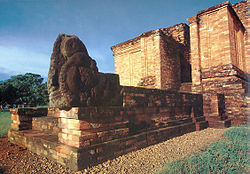Muaro Jambi Regency is a regency of Jambi Province, Sumatra, Indonesia. It was created on 4 October 1999 by the separation of what were formerly the eastern districts of Batang Hari Regency. It surrounds on all sides the major city of Jambi, the provincial capital, and includes many of the expanding suburbs of Jambi outside the city boundaries; consequently it has experienced population growth greater than elsewhere in the province. From the 4th until the 13th century, it was the seat of the Hindu-Buddhist Melayu Kingdom. It has an area of 5,264.00 km2 and had a population of 342,952 at the 2010 census[2] and 390,347 at the 2020 census;[3] the official estimate as at mid 2023 is 418,799 (comprising 215,295 males and 203,504 females).[1]
Muaro Jambi Regency
(Kabupaten Muaro Jambi) | |
|---|---|
 | |
| Motto(s): Sailun Salimbai (As one swing and one wave) | |
 | |
| Country | Indonesia |
| Province | Jambi |
| Regency seat | Sengeti |
| Area | |
• Total | 5,264.00 km2 (2,032.44 sq mi) |
| Population (mid 2023 estimate)[1] | |
• Total | 418,799 |
| • Density | 80/km2 (210/sq mi) |
| Time zone | UTC+7 (WIB) |
| Website | muarojambikab.go.id |
Administrative districts
editAt the time of the 2010 census, the regency was divided into eight districts (kecamatan): Jambi Luar Kota (Jambi city's suburbs), Kumpeh, Kumpeh Ulu, Maro Sebo, Mestong, Sekernan, Sungai Bahar (Bahar River) and Sungai Gelam (Gelam River). Subsequently, another three districts have been added by splitting away from existing districts - Bahar Selatan (South Bahar) and Bahar Utara (North Bahar) from Sungai Bahar District; and Taman Rajo from Maro Sebo District.
These eleven districts are tabulated below with their areas and their populations at the 2010 census[2] and the 2020 census,[3] together with the official estimates as at mid 2023.[1] The table also includes the locations of the district administrative centres, and the number of administrative villages in each district (a total of 150 rural desa and 5 urban kelurahan), and its post code.
| Kode Wilayah |
Name of District (kecamatan) |
Area in km2 |
Pop'n 2010 census |
Pop'n 2020 census |
Pop'n mid 2023 estimate |
Admin centre |
No. of villages |
Post code |
|---|---|---|---|---|---|---|---|---|
| 15.05.05 | Mestong | 474.70 | 37,490 | 40,294 | 41,253 | Sebapo | 15 (a) | 36364 |
| 15.05.07 | Sungai Bahar | 160.50 | 51,170 | 28,359 | 29,268 | Marga Manunggal Jaya | 11 | 36365 |
| 15.05.10 | Bahar Selatan | 195.69 | (b) | 16,349 | 16,863 | Tanjung Mulya | 10 | 36366 |
| 15.05.09 | Bahar Utara | 167.26 | (b) | 13,595 | 14,031 | Talang Bukit | 11 | 36367 |
| 15.05.06 | Kumpeh Ulu | 386.65 | 45,991 | 58,645 | 61,988 | Pudak | 18 | 36373 |
| 15.05.08 | Sungai Gelam | 654.41 | 57,276 | 70,392 | 74,264 | Sungai Gelam | 15 | 36363 |
| 15.05.03 | Kumpeh | 1,658.93 | 24,712 | 24,809 | 25,166 | Tanjung Mulya | 17 (c) | 36371 |
| 15.05.04 | Maro Sebo | 261.47 | 28,179 | 21,368 | 22,354 | Jambi Kecil | 12 (d) | 36382 |
| 15.05.11 | Taman Rajo | 352.67 | (e) | 13,164 | 13,772 | Kemingking Dalam | 10 | 36383 |
| 15.05.01 | Jambi Luar Kota ("Jambi outside the city") |
280.12 | 58,380 | 69,835 | 73,210 | Pijoan | 20 (f) | 36361 (g) |
| 15.05.02 | Sekernan | 671.60 | 39,754 | 45,330 | 46,63 | Sengeti | 16 (h) | 36381 |
| Totals | 5,264.00 | 342,952 | 390,347 | 418,799 | Sengeti | 155 |
Note: (a) includes the kelurahan of Tempino. (b) The 2010 population of the new Bahar Selatan and Bahar Utara districts are included with that of the existing Sungai Bahar District in the far southwest of the regency, from which they were cut out.
(c) includes the kelurahan of Tanjung. (d) includes the kelurahan of Jambi Kecil.
(e) The 2010 population of the new Taman Rajo District is included with that of the existing Maro Sebo District, from which it was cut out. (f) includes the kelurahan of Pijoan.
(g) except the village (desa) of Maro Sebo, which has a post code of 36382. (h) includes the kelurahan of Sengeti.
While Jambi Luar Kota District includes the western suburbs of Jambi city, four other districts immediately adjoin the city on its other sides, notably Kumpeh Ulu District on its east side and Sungai Gelam District to its southeast. The Batang Hari River borders the city on its north side.
Archaeology
editLocated within this regency, the Muaro Jambi Temple Compounds is one of the largest archaeological complex in Sumatra. The archaeological site is located some 22 km downstream from the modern capital, on the opposite bank, it has the ancient Hindu Candi and Menapo or brick-built temples and canals. Restoration of three main structures Candi Tinggi, Candi Gumpung and Candi Kedaton, the last with an unusual fill of small white river pebbles, has been completed.
See also
editReferences
editExternal links
edit- Muarojambi Temple Compound - UNESCO world heritage tentative list
- https://web.archive.org/web/20100521045224/http://inspirasipakde.com/2009/02/17/journey-to-the-past/
- https://web.archive.org/web/20140823075620/http://jambi.bebasnews.com/
1°38′25″S 103°44′38″E / 1.64028°S 103.74389°E
